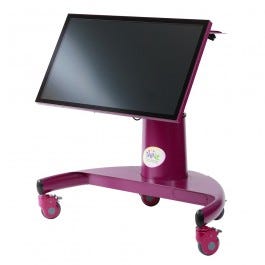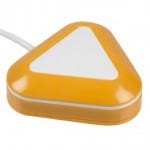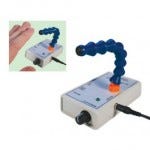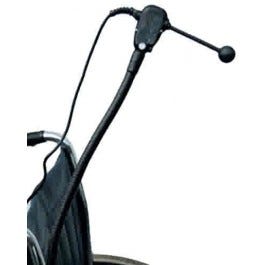Healthy Conversations at ATIA 2023
By: Dr. Raymond Heipp
I have been attending the ATIA conference for over a decade now. Throughout the years from 2010 until 2020, we saw great interaction between some of the most important thinkers and doers in the Special Education realm, the teachers and the influencers who were leading the charge into inclusion. The pandemic put a halt to so many things within our Special Education classrooms, therapy rooms, and overall support that we were able to provide. Our focus was on creating new routines for those who thrived in routine and had it pulled away from them at a moment’s notice. We had to learn new skills and consider so many different perspectives that we were seriously taxed in our own abilities. Even in the face of the stress and anxiety of the global community, we continued moving forward understanding that our roles were critical to so many. A virtual ATIA in 2021 still had great sessions, but there was something missing. When we returned to a hybrid ATIA in 2022, the sessions were again great, but there was still something off about the feeling around the conference.
The 2023 ATIA conference brought back a sense of what was lost – connection. Bruce Springsteen put it best when he sang of the “Human Touch.” That face-to-face connection, without masks for many, and the ability to shake hands, pat someone’s back, or even share hugs returned this conference into the vision of what it should be – a place to connect, share, and augment what we are doing through the ideas of so many others.
I knew it would be different right out of the gate when walking around in the Exhibit Hall during the time for booth set-up. I was approached by a group who asked if I would mind being in a video. They shared with me that they were in a pre-conference workshop and were tasked with creating a video to help first year attendees understand what to expect and what to look for in that hall. Whereas the folks around me and the team doing the videos expected some elevator pitch about why our booth was the best (which it was without needing a pitch!), I put on the old administrator’s hat and shared with them that they should have a student in mind and be asking questions and new ideas about how to support those students. Ironically, that workshop was being led by one of the great influencers and professional development experts today, Kelly Fonner, who tracked me down later. She shared her dual purpose. She was trying to get teachers and administrators comfortable with making videos to support individuals while also hoping to get attendees excited for all aspects of the conference. She was thrilled that this group was able to get a stronger sense of who we are as a community of support while learning those video skills. So why aren’t you creating videos? Even if you don’t want to create them, don’t be afraid to ask others, including myself, for videos to support you. If you haven’t checked out any of the Talkin’ Tech videos or other series I created on YouTube, take some time to check them out to help support your team.
I had the opportunity to interact with Ewa Bukowska and Laura Murden from Cosmo. These two women are brilliant and really helped so many understand how this device could be used for our individuals. Ewa came from the classroom and added so many anecdotes that made sense. If you haven’t seen Cosmo yet, reach out to Jodi Szuter at jszuter@schoolhealth.com for a demo. The device which is sold in packs of one, three, or six can act simply as a Bluetooth switch which has color. However, once connected to the app and using more than one device, it can take individuals on amazing journeys. I watched as people from the DOE of NYC, the GA DOE, and so many others interacted, played games against themselves as well as against their peers. Yet, even with all the fun, there are so many other ways to use these devices including as musical instruments, single message communicators, and answer buttons. On the back end, teachers and therapists can adjust the sensitivity of the devices to either increase or decrease the pressure needed to activate. There are also tools to see how the students were interacting with it as well. This is definitely one of the devices I was most impressed with and happy to have with me while presenting my seminars throughout the country.
Also attending the conference were people representing other major conferences throughout the country. I engaged with people from the IHD Conference in Arizona, the Assistive Technology Conference of New England in Rhode Island, and Closing the Gap in Minnesota. I had some great discussions with these folks around potential presentations and all of them asked for the integration of sensory supports throughout the standard day. I am looking forward to putting those presentations together to better support all individuals. One thing that I do want to share product-wise with you is the Sensory Blackout Tent. This tent comes in a duffel bag and sets up within 15-20 minutes. It is six feet high and is 4’x4’ on the sides. The inside is colored black to give the individuals inside a place to get out of the light and sights of an area. I really like the fact that we could also use this for our students with CVI and bring in a light box or other activities. The best part is that this tent, which can become that portable sensory space, is affordable and can fit into your budget. Aside from the attendees at the show, I also shared the tent with the attendees at my seminar for the Virginia Tech TTAC. Matt and Holly had attended ATIA, so they had an early look at it. I then shared it with the states and other countries who gathered for the Special Olympics of North America workshop days. I continued to stress making sensory supports a part of every student’s day.
No ATIA would be complete without an Edcamp occurring one of the evenings. Mike Marotta, Kelly Suding, Chris Bugaj, and so many others created a session that really allowed for the most important aspect of any Special Education or Assistive Technology conference and that is the networking. Moving from a fun game of “Cards Against Exclusivity” into breakouts focused on topics, this group of individuals are setting a foundation from which we can build a stronger and more unified community. If you are not following them on Twitter, please do so, as well as getting involved in the #atchat sessions they have weekly.
What did I take away from this conference, more information and a whole bunch of positive energy. It was great to be back among this group of professionals. It is always energizing to engage with so many others with the same purpose. Unfortunately, not everyone could attend. However, for those of you who would like to get a flavor of ways to better use the devices you already have and learn about some of the newer devices and sensory supports, please reach out. Whether it be a virtual session or an in-person seminar (with lots of fun stuff), Jodi and I are happy to support you. We are taking the notion of networking and sharing information and bringing it to you.
Thank you for what you do and know that we are returning to the energy and support we once had. Let us know how we can help!




